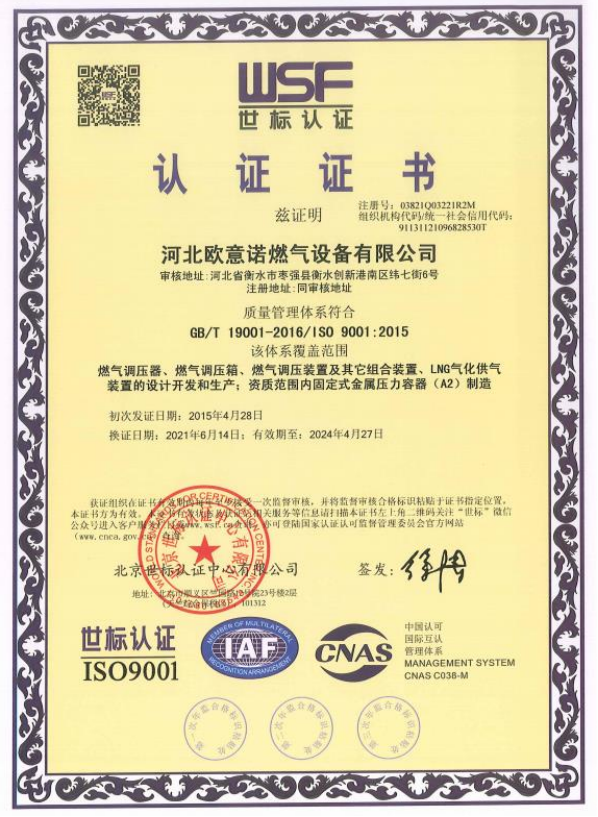
Oct . 02, 2024 05:51
Back to list
Pressure Reduction Station Overview and Operational Insights
The Importance of Pressure Reduction Stations
Pressure reduction stations play a critical role in modern gas distribution systems. They are essential components in ensuring the safe and efficient delivery of natural gas and other pressurized gases from high-pressure transmission pipelines to lower-pressure distribution systems that serve homes, industries, and commercial establishments. This article delves into the significance, functionality, and challenges associated with pressure reduction stations.
Functionality of Pressure Reduction Stations
The primary function of a pressure reduction station (PRS) is to decrease the pressure of gas flowing from high-pressure pipelines to a level that is manageable for local distribution. High-pressure gas is transported over long distances to minimize energy losses, but it is too dangerous for direct use. Therefore, the PRS serves as a crucial intermediary that carefully reduces the pressure to a suitable range, typically between 4 to 60 psi, before it enters the municipal distribution network.
Equipment in a PRS includes pressure regulators, safety valves, filters, and metering devices. The pressure regulators are particularly vital; they automatically adjust to maintain a constant output pressure, regardless of fluctuations in upstream pressure or downstream demand. Safety is a paramount concern in the design and operation of PRS. Therefore, multiple layers of redundancy and monitoring systems are implemented to prevent accidents, leaks, or explosions.
.
As the demand for natural gas increases due to its cleaner-burning properties compared to other fossil fuels, the importance of pressure reduction stations cannot be overstated. They ensure that gas is delivered safely and efficiently to consumers. Additionally, these stations facilitate the integration of renewable energy sources into the gas grid. For instance, biogas produced from organic waste can be processed and injected into the existing pipeline system, provided that the gas is adequately pressurized and meets specific quality standards.
محطة تخفيض الضغط

Moreover, PRS help to manage peak demands efficiently. During peak usage times, these stations can adjust the output pressure to accommodate increased demand while maintaining a stable supply. This capability is essential for balancing energy needs and preventing shortages during high-consumption periods, which are often seasonal.
Challenges and Future Developments
Despite their importance, pressure reduction stations face several challenges. Aging infrastructure and the need for modernization can result in inefficiencies and increased operational risks. Therefore, ongoing maintenance and infrastructure investments are crucial. Additionally, the rising focus on sustainability must be addressed through innovative technologies that enhance the efficiency of PRS while minimizing greenhouse gas emissions.
With the advent of smart technologies, the future of pressure reduction stations holds promise. The integration of sensors and IoT technologies can enable real-time monitoring and data analytics, leading to improved operational efficiency and safety.
Conclusion
In summary, pressure reduction stations are indispensable for safely transitioning high-pressure gas into distribution networks. They are vital for ensuring reliable energy delivery, accommodating increasing demand, and facilitating the integration of renewable energy sources. As the industry moves forward, addressing the challenges faced by PRS will be critical for maintaining a safe, efficient, and sustainable energy system. The evolution of technology in this area will undoubtedly play a significant role in shaping the future of gas distribution.
Latest news
-
Safety Valve Spring-Loaded Design Overpressure ProtectionNewsJul.25,2025
-
Precision Voltage Regulator AC5 Accuracy Grade PerformanceNewsJul.25,2025
-
Natural Gas Pressure Regulating Skid Industrial Pipeline ApplicationsNewsJul.25,2025
-
Natural Gas Filter Stainless Steel Mesh Element DesignNewsJul.25,2025
-
Gas Pressure Regulator Valve Direct-Acting Spring-Loaded DesignNewsJul.25,2025
-
Decompression Equipment Multi-Stage Heat Exchange System DesignNewsJul.25,2025

